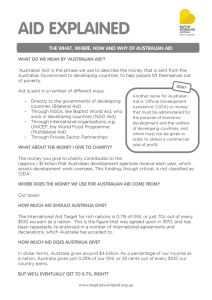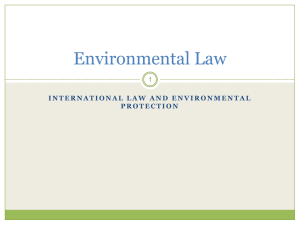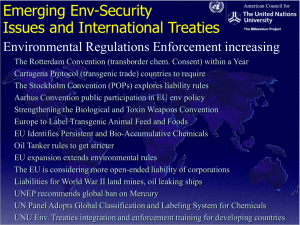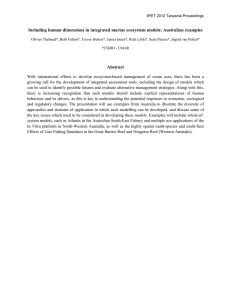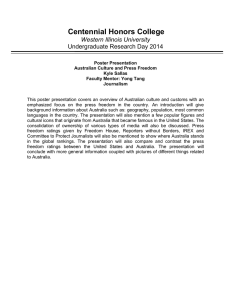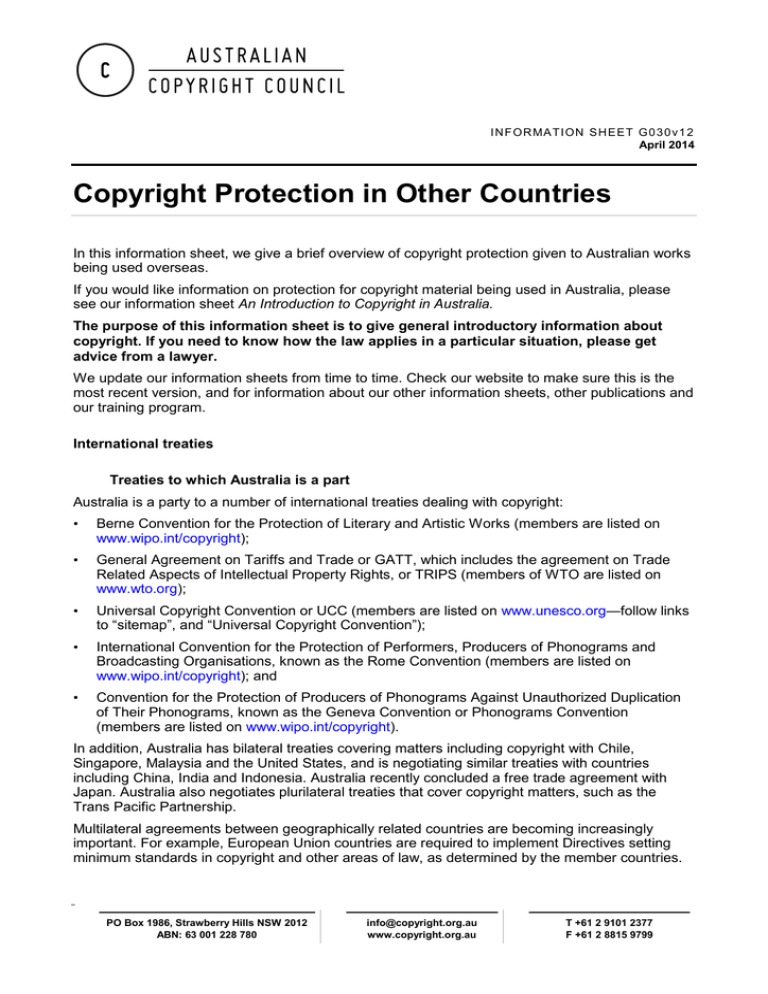
I N F O R MA TI O N S H E E T G 0 3 0 v1 2
April 2014
Copyright Protection in Other Countries
In this information sheet, we give a brief overview of copyright protection given to Australian works
being used overseas.
If you would like information on protection for copyright material being used in Australia, please
see our information sheet An Introduction to Copyright in Australia.
The purpose of this information sheet is to give general introductory information about
copyright. If you need to know how the law applies in a particular situation, please get
advice from a lawyer.
We update our information sheets from time to time. Check our website to make sure this is the
most recent version, and for information about our other information sheets, other publications and
our training program.
International treaties
Treaties to which Australia is a part
Australia is a party to a number of international treaties dealing with copyright:
•
Berne Convention for the Protection of Literary and Artistic Works (members are listed on
www.wipo.int/copyright);
•
General Agreement on Tariffs and Trade or GATT, which includes the agreement on Trade
Related Aspects of Intellectual Property Rights, or TRIPS (members of WTO are listed on
www.wto.org);
•
Universal Copyright Convention or UCC (members are listed on www.unesco.org—follow links
to “sitemap”, and “Universal Copyright Convention”);
•
International Convention for the Protection of Performers, Producers of Phonograms and
Broadcasting Organisations, known as the Rome Convention (members are listed on
www.wipo.int/copyright); and
•
Convention for the Protection of Producers of Phonograms Against Unauthorized Duplication
of Their Phonograms, known as the Geneva Convention or Phonograms Convention
(members are listed on www.wipo.int/copyright).
In addition, Australia has bilateral treaties covering matters including copyright with Chile,
Singapore, Malaysia and the United States, and is negotiating similar treaties with countries
including China, India and Indonesia. Australia recently concluded a free trade agreement with
Japan. Australia also negotiates plurilateral treaties that cover copyright matters, such as the
Trans Pacific Partnership.
Multilateral agreements between geographically related countries are becoming increasingly
important. For example, European Union countries are required to implement Directives setting
minimum standards in copyright and other areas of law, as determined by the member countries.
PO Box 1986, Strawberry Hills NSW 2012
ABN: 63 001 228 780
info@copyright.org.au
www.copyright.org.au
T +61 2 9101 2377
F +61 2 8815 9799
2
Australian Copyright Council Information Sheet G030v12 Copyright protection in other countries
WIPO treaties
Two international treaties were adopted in Geneva on 20 December 1996, following the World
Intellectual Property Organization (WIPO) Diplomatic Conference on Certain Copyright and
Neighboring Rights Questions. The treaties are:
•
the WIPO Copyright Treaty; and
•
the WIPO Performances and Phonograms Treaty.
Members of these treaties are listed at www.wipo.int/copyright
The Treaties supplement the provisions of both the Berne Convention and the Rome Convention
by providing expanded rights for copyright owners, performers and phonogram producers,
including a right of communication to the public to cover online transmissions of copyright material,
such as over the internet, a right of “distribution” and moral rights for performers.
Both treaties are now in force. Legislation intended to bring Australia into compliance with the
WIPO treaties was passed in 2004. Most of these amendments came into effect on 1 January
2005 and others came into operation in mid-2009.
Effects of international copyright treaties
To become a party to the international copyright treaties, a country must legislate to achieve a
minimum standard of copyright protection.
In most cases, it must also give protection for copyright material from all the countries which are
party to the treaty (“national treatment”).
Most countries grant copyright protection to Australian material under international treaties. The
countries that do this include: Canada, China, France, Germany, Hong Kong, Indonesia, Japan,
South Korea, Malaysia, New Zealand, Singapore, the United Kingdom and the United States.
Minimum standards of copyright protection ensure that there is a basic level of copyright protection
in all member countries, although the ways in which the legislation is implemented need not be
uniform. Some examples of the kinds of minimum protection required are set out below. Many
countries provide more extensive protection than the minimum required by treaties.
Type of material protected
The Berne Convention and TRIPS require countries to protect a range of material, including:
•
written material such as books and reports;
•
music;
•
dramatic works such as plays and choreography;
•
artistic works such as paintings, drawings and photographs;
•
architectural works; and
•
cinematograph works such as films and videos.
TRIPS expressly requires protection of computer programs and certain databases; there appears
to be international agreement that the Berne Convention also requires protection of computer
programs and certain databases.
Rights reserved to copyright owners
The treaties require certain rights to be granted in relation to the material covered by the treaty,
such as rights relating to reproduction, public performance and communication of copyright works.
PO Box 1986, Strawberry Hills NSW 2012
ABN: 63 001 228 780
info@copyright.org.au
www.copyright.org.au
T +61 2 9101 2377
F +61 2 8815 9799
3
Australian Copyright Council Information Sheet G030v12 Copyright protection in other countries
Types of people and activities protected
The Rome Convention and TRIPS require protection for performers, phonogram producers and
broadcasting organisations. The Phonograms Convention requires protection for phonogram
producers.
Term of copyright protection
The treaties require minimum terms of protection for the material they require to be protected. For
example, the Berne Convention requires most works to be protected for the life of the author plus
50 years. However, some bilateral and multilateral agreements require longer periods of
protection. For example, European Union countries are required to protect most works for the life
of the author plus 70 years and copyright protection in Australia lasts for 70 years after the life of
the author (with some exceptions, such as where the author died before 1955). For more
information, see our information sheet Duration of Copyright.
Protection for overseas material — “national treatment”
All the major copyright treaties require party states to give “national treatment”. This means that
member states agree to extend the same copyright protection to works first published in, or
created by nationals of, other member states as they do to works first published in their own
country or created by their own nationals. This is called “national treatment”. This means that if
copyright in an Australian work is infringed in, say, Japan, the copyright owner will be able to take
an action under Japanese law and will be entitled to the same protection as a Japanese copyright
owner.
Requirements for protection overseas
Most of the treaties require automatic protection, without formalities such as registration. The
UCC, however, allows member countries to deny protection if the copyright notice does not appear
on copies of published works. This is only relevant in practice if the country is party to the UCC
and not party to the Berne Convention or GATT.
Before 1989, the United States denied protection to certain materials published without the
copyright notice. However, copyright protection in the Unites States is now free and automatic.
(See also our comments below concerning registration systems in other countries.)
The “copyright notice”
The “copyright notice” does not need to be on something before it is protected by copyright in
Australia or in most other countries, but it does remind people that the work may be protected and
identifies the person claiming the rights. In some cases, in Australia and some other countries, the
notice can be used to provide evidence of ownership of copyright (although this is not conclusive).
Copyright owners can put the notice on their work themselves; there is no formal procedure. The
notice consists of the symbol ©, followed by the name of the copyright owner and the year of first
publication: for example, “© Gus O’Donnell 1968”.
For a work that is constantly updated, such as material on a website, it is possible to include the
years from the time of first publication to the present: for example, “© Gus O’Donnell 1998–2005”.
Sometimes you will see the words “All rights reserved” as well as, or instead of, the copyright
notice. This is not necessary under Australian law. However, if you will be publishing or distributing
in some South American countries, use of this phrase may be advisable.
If you think that the first publication of your work will be in a country outside Australia, you should
seek advice from a suitably qualified solicitor in private practice.
PO Box 1986, Strawberry Hills NSW 2012
ABN: 63 001 228 780
info@copyright.org.au
www.copyright.org.au
T +61 2 9101 2377
F +61 2 8815 9799
4
Australian Copyright Council Information Sheet G030v12 Copyright protection in other countries
Phonograms notice
For sound recordings, the letter “P” (for phonogram) in a circle or in brackets is used instead of the
“C in a circle”. The Phonograms Convention allows a member country to require the symbol and
the year of first publication to appear on copies of sound recordings (CDs or audiotapes, for
example) in order to be protected in that country. Whether or not such a notice is required
depends on the legislation in the particular country in which the sound recording will be published.
Countries with registration systems
Some countries, such as the United States, have systems for registering copyright material. As
discussed above, it is not necessary for Australian material to be registered in order to receive
copyright protection, if the country is a party to one of the copyright treaties. In some cases,
however, there may be practical advantages in getting registration if the work will be published or
distributed in a country with a registration system. In Australia, evidence of registration of copyright
in another country may (like use of the copyright notice) be used as evidence of copyright
ownership in legal proceedings, although it is not conclusive.
For information about registration of copyright in the United States, go to www.copyright.gov
Moral rights protection overseas
In Australia, creators automatically have moral rights in relation to works they create. No
procedure is required. For further information, see our information sheet Moral Rights.
However, in some countries (including the United Kingdom and New Zealand), it is necessary to
assert the attribution right in order to be able to enforce it. This is usually done by including in a
published work a statement such as “The moral rights of the author(s) have been asserted” or
“The author’s right to be identified has been asserted”. If your work will be published or distributed
outside Australia, you should seek advice on this issue from a suitably qualified solicitor in private
practice.
Other international resources
World Intellectual Property Organization (WIPO)
World Trade Organization
U.S. Copyright Office
UK Intellectual Property Office
Copyright Licensing Agency (UK)
www.wipo.int
www.wto.org
www.copyright.gov
www.ipo.gov.uk
www.cla.co.uk
Further information
For further information about copyright, and about our other publications and seminar program,
see our website – www.copyright.org.au
If you meet our eligibility guidelines, a Copyright Council lawyer may be able to give you free
preliminary legal advice about an issue that is not addressed in an information sheet. This service
is primarily for professional creators and arts organisations but is also available to staff of
educational institutions and libraries. For information about the service, see
http://www.copyright.org.au/legal-advice/
Reproducing this information sheet
Our information sheets are regularly updated - please check our website to ensure you are
accessing the most current version. Should you wish to use this information sheet for any purpose
other than your reference, please contact us for assistance.
PO Box 1986, Strawberry Hills NSW 2012
ABN: 63 001 228 780
info@copyright.org.au
www.copyright.org.au
T +61 2 9101 2377
F +61 2 8815 9799
5
Australian Copyright Council Information Sheet G030v12 Copyright protection in other countries
About Us
The Australian Copyright Council is an independent, non-profit organisation. Founded in 1968, we
represent the peak bodies for professional artists and content creators working in Australia’s
creative industries and Australia’s major copyright collecting societies.
We are advocates for the contribution of creators to Australia’s culture and economy; the
importance of copyright for the common good. We work to promote understanding of copyright law
and its application, lobby for appropriate law reform and foster collaboration between content
creators and consumers.
We provide easily accessible and affordable practical, user-friendly information, legal advice,
education and forums on Australian copyright law for content creators and consumers.
The Australian Copyright Council has been assisted by the
Australian Government through the Australia Council, its
arts funding and advisory body.
© Australian Copyright Council 2014
PO Box 1986, Strawberry Hills NSW 2012
ABN: 63 001 228 780
info@copyright.org.au
www.copyright.org.au
T +61 2 9101 2377
F +61 2 8815 9799

